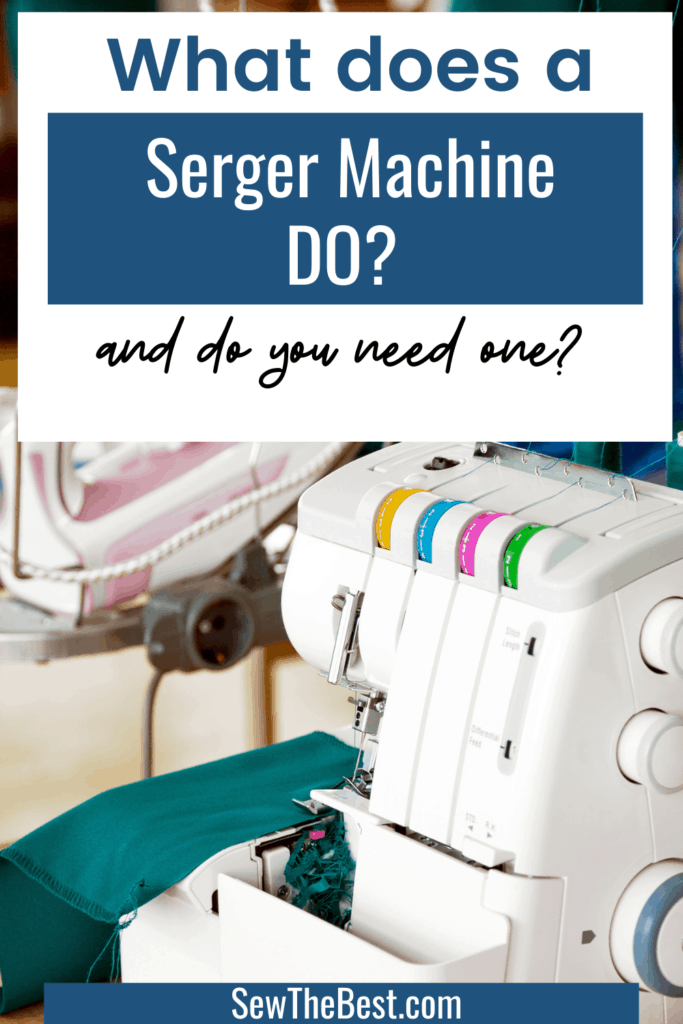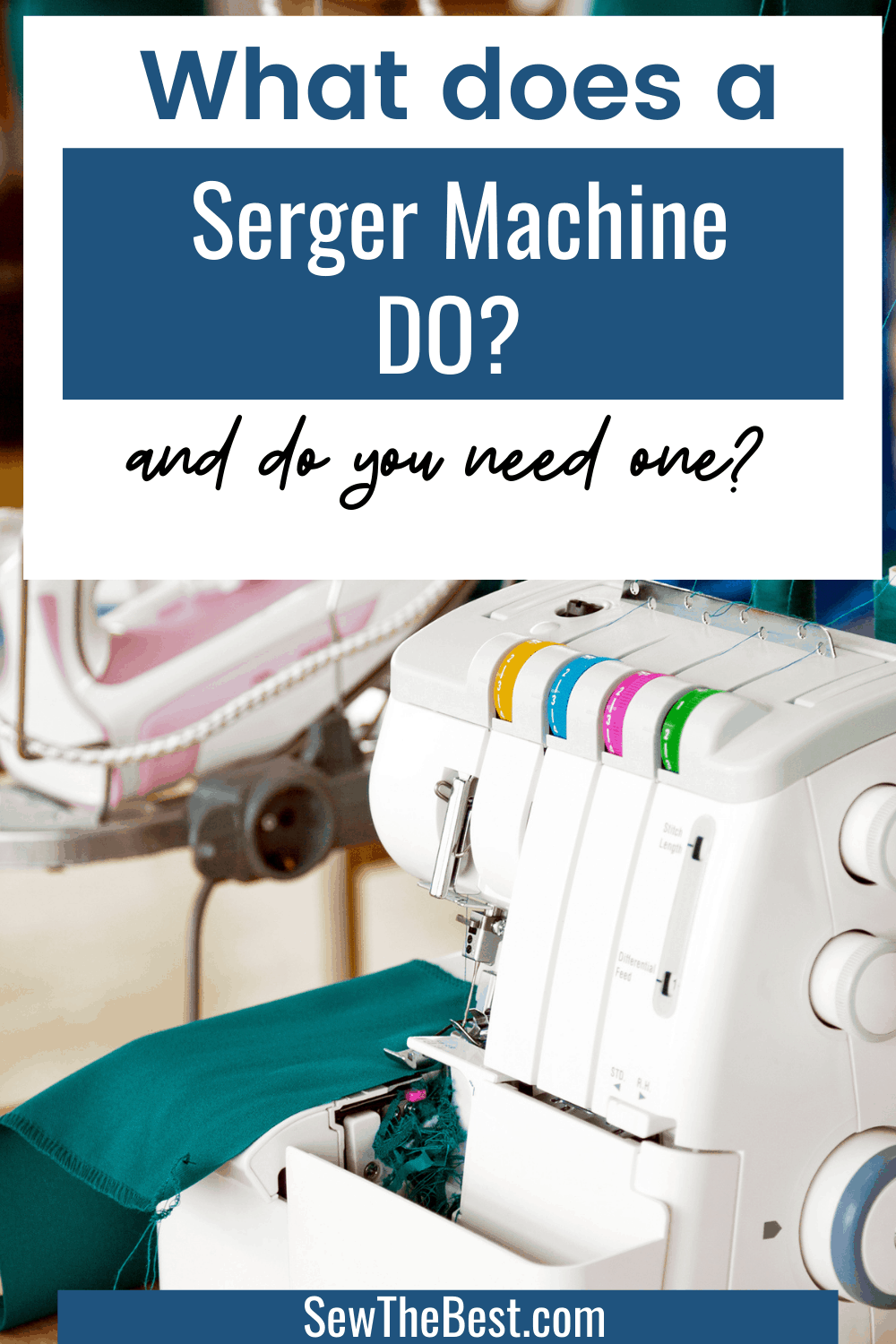Are you debating getting a serger machine, or just curious about them? This post goes over everything there is to know about sergers. What does a serger do and do you need one? What does a serger machine do? What stitches can a serger make? Learn about sergers with this post and get the answers to all of these questions and more.

What is a serger used for?
A serger is a type of machine for sewing that is specialized for finishing the edges of fabric. When you cut fabric, you are cutting all of the threads that the fabric is made up of. If left unprotected, these threads will cause your fabric to come unraveled and your project to fall apart. A serger protects and strengthens all of these cut threads. It does this by wrapping anywhere from three to five or more threads around the fabric encasing the cut ends.
How much does a serger cost?
The price of sergers varies quite a bit depending on the serger. Basic home sergers usually start at around $300. Sergers can go up rapidly from there depending on the different features that they have available. Sergers that can be converted to do more than one stitch cost much more than sergers dedicated to one stitch type. Heavy duty or industrial grade sergers cost even more. As with all things, when buying a serger it is much more important to know what features you want and to check reviews than to rely on the cost of the machine to determine if you want it.
Check out the best Brother serge machines for sale.
What is an overlock machine?
An overlock machine is a type of serger that can do an overlock stitch. Overlock stitch is a stitch that goes over and off the raw edge of the fabric. Think of it as wrapping over the fabric and locking the edge into place. You commonly see this type of stitch on the inside of garments. Body seams and shoulder seams are often overlocked. Overlock threads can be sewn with two, three, or four threads. Four threaded overlock stitches are more durable. This stitch is great for medium to heavy weight fabric like a denim. Three threaded overlock stitches are a bit less durable, but are quite a bit more stretchy. This is a great stitch for cotton knits. A two thread overlock stitch is even less durable. This stitch would be used on the lightest of fabrics. Perhaps the best part of the overlock stitch is that just before the stitch is made, a knife attached to the machine trims the edges of the fabric. This ensures that the encased edge is smoothly and exactly trimmed to be the same size as the stitching, guaranteeing that your edges are properly encased in thread.
Some overlock machines are capable of doing more than just an overlock stitch, so be sure to check this out if you are thinking about buying an overlock machine.
Do I need a serger?
You do not need a serger to sew many wonderful and beautiful projects. Any project that you sew should have the ends properly finished and protected. There are ways of doing this both by hand and by sewing machine that are quite adequate. Rolled seams, french seams, zig zag stitch and more all work quite well to protect the edges of your fabric.
However, if you are looking for the fastest and most durable way to create professional fabric edges that last, you should get a serger. Sergers are capable of many different stitches that can be used for many different edge finishes. Make sure you pick a serger that can do the type of stitch that you need.
How is a serger different from a sewing machine?
Sergers are different from sewing machines in many different ways. The biggest difference in them though is their capabilities. Sewing machines are general fabric sewing machines often capable of doing many different things. Sewing machines can join pieces of fabric together, finish edges, quilt, embroider, and more. In contrast, sergers are specialized for finishing the raw edges of your fabric. Sergers can join two pieces of fabric together with a couple of their stitches, but they are not true sewing machines.
Here’s a great video detailing the differences between a serger and a sewing machine.
What stitches can a serger do?
What does a serger machine do? Sergers can do many different types of stitches. Make sure that you pick a stitch that complements your project. Here are five of the more common stitches that sergers can do.
Overlock Stitch
This is one of the most common serger stitches. This stitch is made for going over the edges of raw fabric and locking the cut threads into place. This stitch is great for both knits and woven materials. In general, the 4 thread overlock is the most durable, the three thread overlock is less durable but more stretchy, and the two thread overlock is the least durable. Machines that can do the overlock stitch are often called overlockers or overlock machines, so keep this in mind when you are looking at sergers.
Coverstitch
The coverstitch used for finishing the bottom and sleeve edges on t-shirts. This stitch has the fabric folded over on itself, with the raw edge encased in threads to secure it. This stitch is very durable and stretchy. It is great for sportswear and cotton knits. Machines that can do coverstitch are often called coverstitch machines.
Check out the best sergers with coverstitch.
Flatlock Stitch
The flatlock stitch is used to sew two pieces of fabric together with a seam that lays flat. This stitch is great for piecing together fabric or for creating any type of seam that you want to lay flat such as on sportswear. Like the overlock stitch, a three thread flatlock stitch is more durable than a two thread flatlock, and a two thread flatlock stitch is more stretchy.
Rolled-hem Stitch
With the rolled-hem stitch, the fabric is automatically rolled over by the serge machine as it sews. This can again be a two or three thread stitch. The rolled-hem stitch is great as a decorative edging to pieces like baby blankets and tablecloths. Two threaded rolled-hem stitch is often used on sheers to edge the fabric.
Chain Stitch
The chain stitch on a serger looks like a chain of threads being sewn on your fabric. This stitch can be used for basting, decoration, or producing chains of thread. This is not a stretchy stitch, and it can unravel easily. The unravelling makes it particularly great for basting where you might need a temporary hold on a piece while it is being fitted.
Should I get a serger?
After learning about sergers, you’re wondering “Should I get a serger?”. Sergers are very useful machines that can take your sewing to the next level.
One of the main benefits of a serger is the different stitch types that it has. Sewing machines only have a few different type of edge finishing stitches. Most of the edge finishing stitches that are available with a sewing machine are non-stretchy. Sergers on the other hand can do many different edge finishing stitches with many different properties. Some edge finishing stitches are strong and sturdy and will not stretch or give at all. Other edge finishing stitches are a mix of stretchy and sturdy, great for things like leggings and t-shirts. Other stitches are light and airy, perfect for finishing the edges of fine gauzes.
Sergers also sew significantly faster than sewing machines. If you find yourself finishing the edges of a lot of fabric, using a serger instead of a sewing machine can save you considerable amounts of time.
So, if you find that you need different options for finishing your fabric edges or you just want to save some time with finishing the edges of your projects, then you should get a serger.
Should I get a serger or a sewing machine?
Should you get a serger or a sewing machine? The answer to this question will be – it depends on what you need. If you do not already have a sewing machine and are looking to start sewing, you should purchase a sewing machine. You can go here to check out the best sewing machines under 200. If you already have a sewing machine and are looking for ways to speed up your work or you want to improve the quality of your sewn items you should consider getting a serger. Sergers are dedicated to finishing and protecting the cut edges of fabric. Using a serger on your projects will help them last longer and look more professional.
Related posts
- Want to know more about sergers? Check out this post about the best Brother sergers for sale.
- Want a great serger with lots of different stitch choices? Check out this post about the best serge machines with coverstitch.
